NVIDIA's GeForce GTX 580: Fermi Refined
by Ryan Smith on November 9, 2010 9:00 AM ESTPower, Temperature, and Noise
Last but not least as always is our look at the power consumption, temperatures, and acoustics of the GTX 580. NVIDIA’s performance improvements were half of the GTX 580 story, and this is the other half.
Starting quickly with voltage, as we only have one card we can’t draw too much from what we know, but there are still some important nuggets. NVIDIA is still using multiple VIDs, so your mileage may vary. What’s clear from the start though is that NVIDIA’s operating voltages compared to the GTX 480 are higher for both idle and load. This is the biggest hint that leakage has been seriously dealt with, as low voltages are a common step to combat leakage. Even with these higher voltages running on a chip similar to GF100, overall power usage is still going to be lower. And on that note, while the voltages have changed the idle clocks have not; idle remains at 50.6MHz for the core.
| GeForce GTX 480/580 Voltages | |||||
| Ref 480 Load | Ref 480 Idle | Ref 580 Load | Ref 580 Idle | ||
| 0.959v | 0.875v | 1.037v | 0.962v | ||
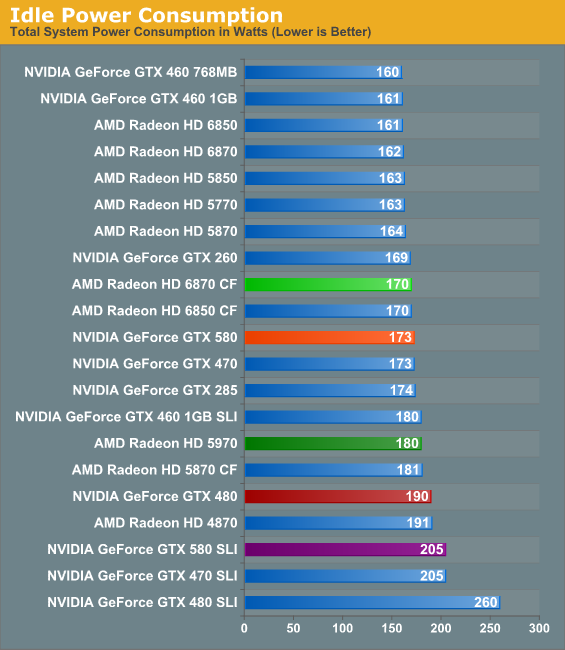
Beginning with idle power, we’re seeing our second biggest sign that NVIDIA has been tweaking things specifically to combat leakage. Idle power consumption has dropped by 17W on our test system even though the idle clocks are the same and the idle voltage higher. NVIDIA doesn’t provide an idle power specification, but based on neighboring cards idle power consumption can’t be far off from 30-35W. Amusingly it still ends up being more than the 6870 CF however, thanks to the combination of AMD’s smaller GPUs and ULPS power saving mode for the slave GPU.
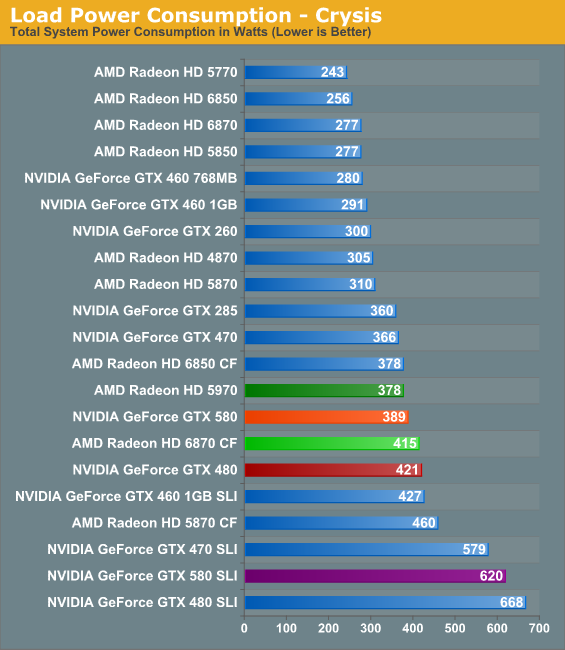
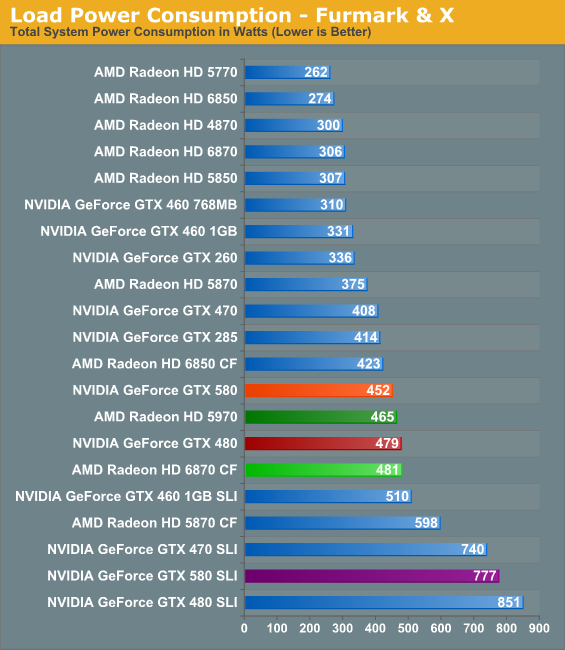
Looking at Crysis, we begin to see the full advantage of NVIDIA’s optimizations and where a single GPU is more advantageous over multiple GPUs. Compared to the GTX 480 NVIDIA’s power consumption is down 10% (never mind the 15% performance improvement), and power consumption comes in under all similar multi-GPU configurations. Interestingly the 5970 still draws less power here, a reminder that we’re still looking at cards near the peak of the PCIe specifications.
As for FurMark, due to NVIDIA’s power throttling we’ve had to get a bit creative. FurMark is throttled to the point where the GTX 580 registers 360W, thanks to a roughly 40% reduction in performance under FurMark. As a result for the GTX 580 we’ve swapped out FurMark for another program that generates a comparable load, Program X. At this point we’re going to decline to name the program, as should NVIDIA throttle it we may be hard pressed to determine if and when this happened.
In any case, under FurMark & X we can see that once again NVIDIA’s power consumption has dropped versus the GTX 480, this time by 27W or around 6%. NVIDIA’s worst case scenario has notably improved, and in the process the GTX 580 is back under the Radeon HD 5970 in terms of power consumption. Thus it goes without saying that while NVIDIA has definitely improved power consumption, the GTX 580 is still a large, power hungry GPU.
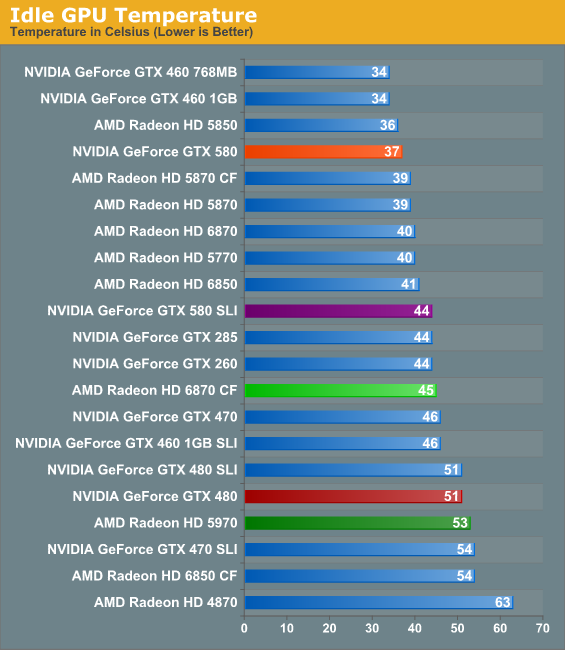
With NVIDIA’s improvements in cooling and in idle power consumption, there’s not a result more dramatic than idle GPU temperatures. The GTX 580 isn’t just cooler, it’s cool period. 37C is one of the best results out of any of our midrange and high-end GPUs, and is a massive departure from the GTX 480 which was at least warm all the time. As we’ll see however, this kind of an idle temperature does come with a small price.
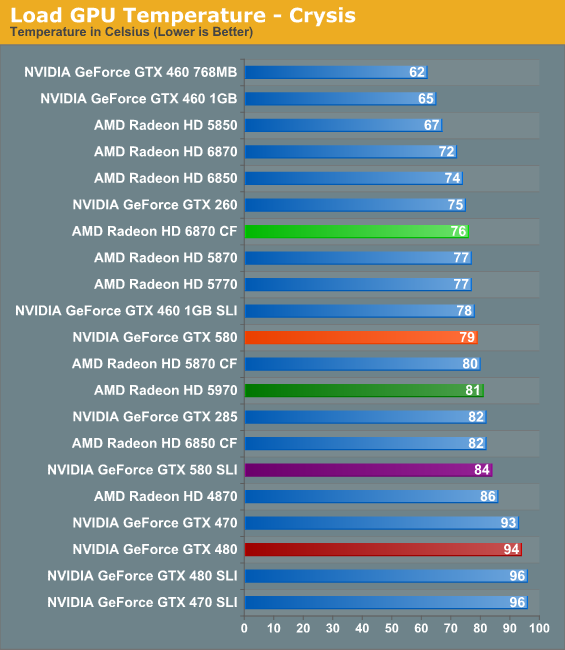
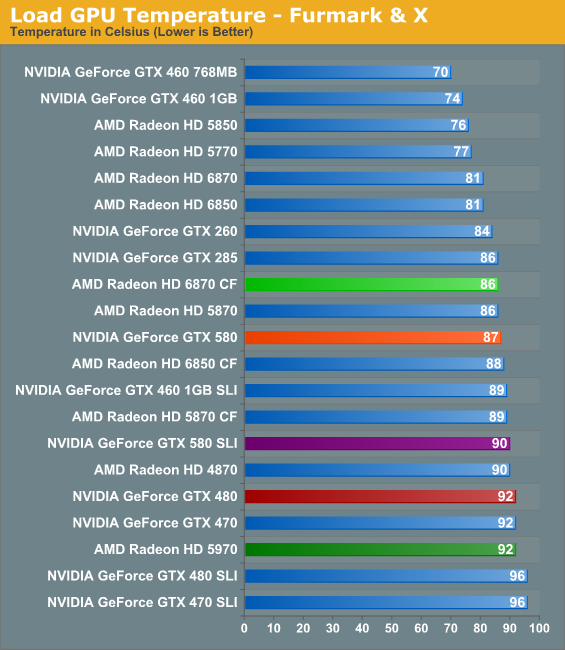
The story under load is much the same as idle: compared to the GTX 480 the GTX 580’s temperatures have dramatically dropped. At 79C it’s in the middle of the pack, beating a number of single and multi GPU setups, and really only losing to mainstream-class GPUs and the 6870 CF. While we’ve always worried about the GTX 480 at its load temperatures, the GTX 580 leaves us with no such concerns.
Meanwhile under FurMark and Program X, the gap has closed, though the GTX 580 remains in the middle of the pack. 87C is certainly toasty, but it’s still well below the thermal threshold and below the point where we’d be worried about it. Interestingly however, the GTX 580 is actually just a bit closer to its thermal threshold than the GTX 480 is; NVIDIA rated the 480 for 105C, while the 580 is rated for 97C. We’d like to say this vindicates our concerns about the GTX 480’s temperatures, but it’s more likely that this is a result of the transistors NVIDIA is using.
It’s also worth noting that NVIDIA seems to have done away with the delayed fan ramp-up found on the GTX 480. The fan ramping on the GTX 580 is as near as we can tell much more traditional, with the fan immediately ramping up with higher temperatures. For the purposes of our tests, this keeps the temperatures from spiking as badly.
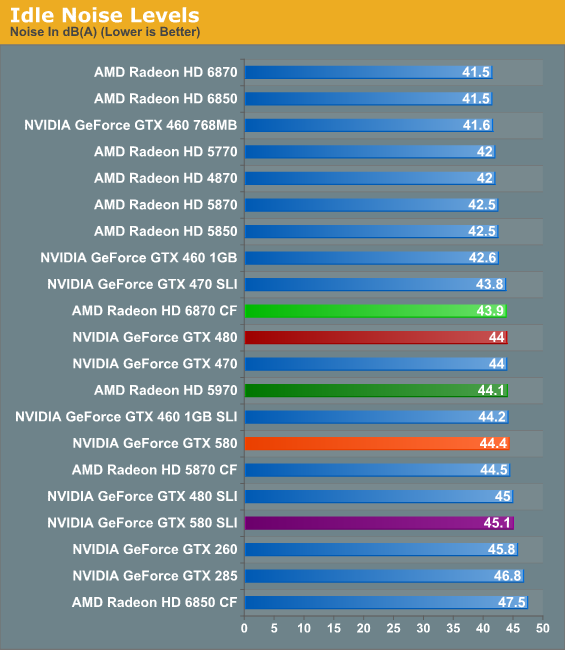
Remember where we said there was a small price to pay for such low idle temperatures? This is it. At 44.4dB, the 580 is ever so slightly (and we do mean slightly) louder than the GTX 480; it also ends up being a bit louder than the 5970 or 6870CF. 44.4 is not by any means loud, but if you want a card that’s whisper silent at idle, the GTX 580 isn’t going to be able to deliver.
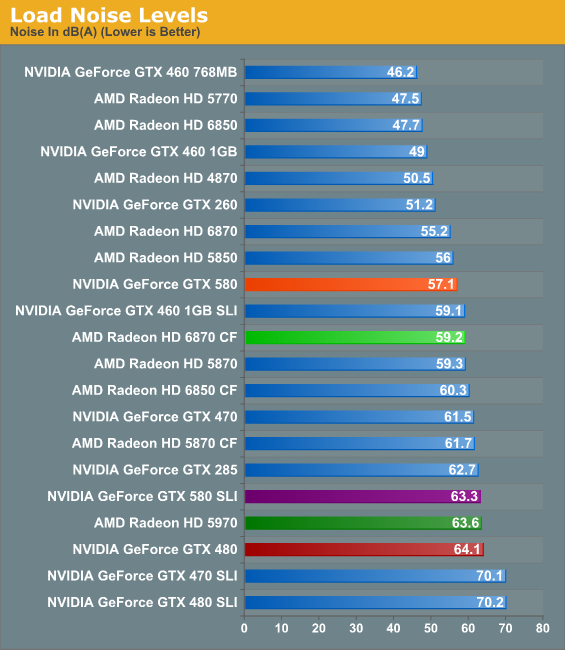
And last but not least is load noise. Between their improvements to power consumption and to cooling, NVIDIA put a lot of effort in to the amount of noise the GTX 580 generates. Where the GTX 480 set new records for a single GPU card, the GTX 580 is quieter than the GTX 285, the GTX 470, and even the Radeon HD 5870. In fact it’s only a dB off of the 5850, a card under most circumstances we’d call the epitome of balance between performance and noise. Graphs alone cannot demonstrate just how much of a difference there is between the GTX 480 and GTX 580 – the GTX 580 is not whisper quiet, but at no point in our testing did it ever get “loud”. It’s a truly remarkable difference; albeit one that comes at the price of pointing out just how lousy the GTX 480 was.
Often the mark of a good card is a balance between power, temperature, and noise, and NVIDIA seems to have finally found their mark. As the GTX 580 is a high end card the power consumption is still high, but it’s no longer the abnormality that was the GTX 480. Meanwhile GPU temperatures have left our self-proclaimed danger zone, and yet at the same time the GTX 580 has become a much quieter card under load than the GTX 480. If you had asked us in what NVIDIA needed to work on with the GTX 480, we would have said noise, temperature, and power consumption in that order; the GTX 580 delivers on just what we would have wanted.










160 Comments
View All Comments
cjb110 - Tuesday, November 9, 2010 - link
"The thermal pads connecting the memory to the shroud have once again wiped out the chip markets", wow powerful adhesive that! Bet Intel's pissed.cjb110 - Tuesday, November 9, 2010 - link
"While the difference is’ earthshattering, it’s big enough..." nt got dropped, though not yet at my workplace:)Invader Mig - Tuesday, November 9, 2010 - link
I don't know the stance on posting links to other reviews since I'm a new poster, so I wont. I would like to make note that in another review they claim to have found a work around the power throttling that allowed them to use furmark to get accurate temps and power readings. This review has the 580 at 28w above the 480 at max load. I don't mean to step on anyone's toe's, but I have seen so many different numbers because of this garbage nvidia has pulled, and the only person who claims to have furmark working gets higher numbers. I would really like to see something definitive.7Enigma - Tuesday, November 9, 2010 - link
Here's my conundrum. What is the point of something like Furmark that has no purpose except to overstress a product? In this case the 580 (with modified X program) doesn't explode and remains within some set thermal envelope that is safe to the card. I like using Crysis as it's a real-world application that stresses the GPU heavily.Until we have another game/program that is used routinely (be it game or coding) that surpasses the heat generation and power draw of Crysis I just don't see the need to try to max out the cards with a benchmark. OC your card to the ends of the earth and run something real, that is understandable. But just using a program that has no real use to artificially create a power draw just doesn't have any benefit IMO.
Gonemad - Tuesday, November 9, 2010 - link
I beg to differ. (be careful, high doses of flaming.)Let me put it like this. The Abrams M1 Tank is tested on a 60º ramp (yes, that is sixty degrees), where it must park. Just park there, hold the brakes, and then let go. It proves the brakes on a 120-ton 1200hp vehicle will work. It is also tested on emergency brakes, where this sucker can pull a full stop from 50mph on 3 rubber-burning meters. (The treads have rubber pads, for the ill informed).
Will ever a tank need to hold on a 60º ramp? Probably not. Would it ever need to come to a screeching halt in 3 meters? In Iraqi, they probably did, in order to avoid IEDs. But you know, if there were no prior testing, nobody would know.
I think there should be programs specifically designed to stress the GPU in unintended ways, and it must protect itself from destruction, regardless of what code is being thrown at it. NVIDIA should be grateful somebody pointed that out to them. AMD was thankful when they found out the 5800 series GPUs (and others, but this was worse) had lousy performance on 2D acceleration, or none at all, and rushed to fix its drivers. Instead, NVIDIA tries to cheat Furmark by recognizing its code and throttling. Pathetic.
Perhaps someday, a scientific application may come up with repeatable math operations that just behave exactly like Furmark. So, out of the blue, you got a $500 worth of equipment that gets burned out, and nobody can tell why??? Would you like that happening to you? Wouldn't you like to be informed that this or that code, at least, could destroy your equipment?
What if Furmark wasn't designed to stress GPUs, but it was an actual game, (with furry creatures, lol)?
Ever heard of Final Fantasy XIII killing off PS3s for good, due to overload, thermal runaway, followed by meltdown? Rumors are there, if you believe them is entirely to you.
Ever heard of Nissan GTR (skyline) being released with a top-speed limiter with GPS that unlocks itself when the car enters the premises of Nissan-approved racetracks? Inherent safety, or meddling? Can't you drive on a Autoban at 300km/h?
Remember back in the day of early benchmark tools, (3DMark 2001 if I am not mistaken), where the Geforce drivers detected the 3DMark executable and cheated the hell out of the results, and some reviewers got NVIDIA red-handed when they renamed and changed the checksum of the benchmark??? Rumors, rumors...
The point is, if there is a flaw, a risk of an unintended instruction kill the hardware, the buyer should be rightfully informed of such conditions, specially if the company has no intention at all to fix it. Since Anand warned us, they will probably release the GTX 585 with full hardware thermal safeties. Or new drivers. Or not.
Just like the instruction #PROCHOT was inserted in the Pentium (which version?) and some reviewers tested it against an AMD chip. I never forgot that AMD processor billowing blue smoke the moment the heatsink was torn off. Good PR, bad PR. The video didn´t look fake to me back then, just unfair.
In the end, it becomes matter of PR. If suddenly all the people that played Crysis on this card caused it to be torched, we would have something really interesting.
Sihastru - Tuesday, November 9, 2010 - link
AMD has a similar system in place since the HD4xx0 generation. Remember when Furmark used to blow up 48x0 cards? Of course not. But look it up...What nVidia did here is what AMD has in all their mid/high end cards since HD4xx0. At least nVidia will only throttle when it detects Furmark/OCCT. AMD cards will throttle in any situation if the power limiter requires it.
JimmiG - Tuesday, November 9, 2010 - link
It's a very unfortunate situation that both companies are to blame for. That's what happens when you push the limits of power consumption and heat output too far while at the same time trying to keep manufacturing costs down.The point of a stress test is to push the system to the very limit (but *not* beyond it, like AMD and Nvidia would have you believe). You can then be 100% assured that it will run all current and future games and HPC applications, not matter what unusual workloads they dump on your GPU or CPU, without crashes or reduced performance.
cactusdog - Tuesday, November 9, 2010 - link
So if you want to use multiple monitors do you still need 2 cards to run it or have they enabled a third monitor on the 580?Sihastru - Tuesday, November 9, 2010 - link
Yes.Haydyn323 - Tuesday, November 9, 2010 - link
The 580 as with the previous generation still only supports 2 monitors max per card.